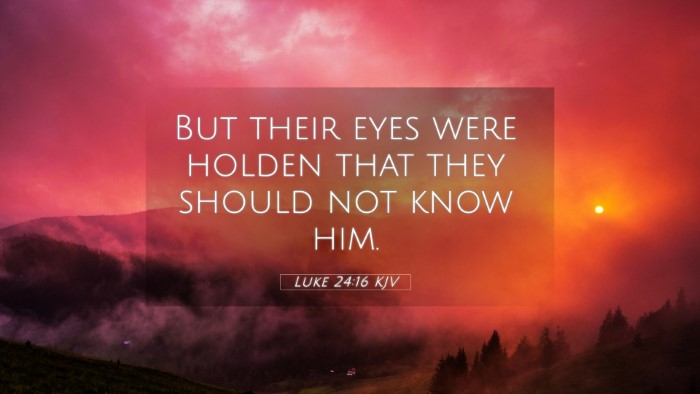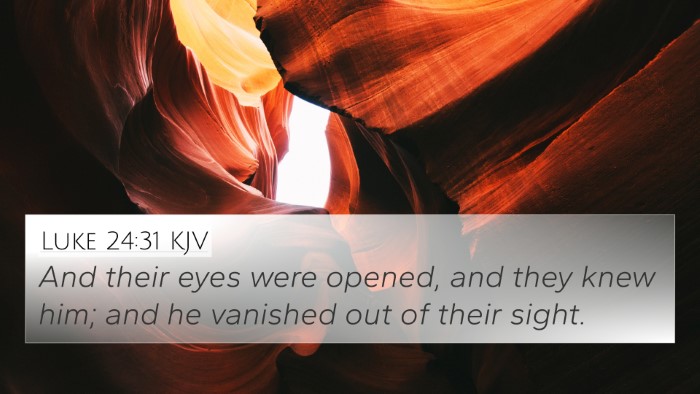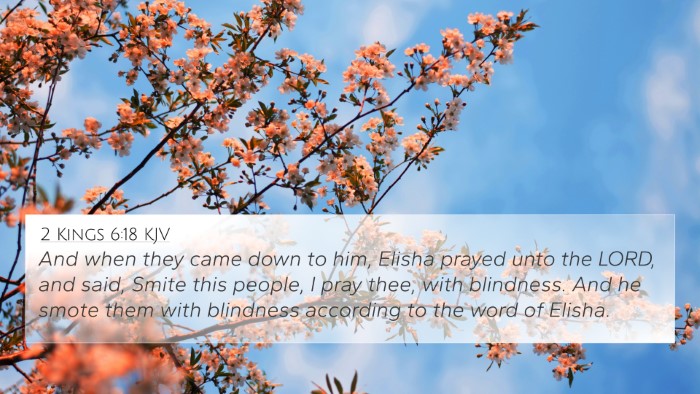Understanding Luke 24:16
In Luke 24:16, we find a fascinating moment post-resurrection where "But their eyes were holden that they should not know him." This verse encapsulates a crucial point in the narrative that leads to a greater understanding of Christ's identity and mission, blending well with various biblical themes.
Contextual Background
This event takes place on the road to Emmaus, where two disciples are discussing the recent events of Jesus' crucifixion and the reports of His resurrection. The phrase "their eyes were holden" indicates a divine intervention where they were prevented from recognizing Jesus immediately.
Core Insights
-
Divine Timing: Matthew Henry emphasizes that God sometimes blinds the eyes of individuals to His truth for His purposes. Their inability to recognize Jesus serves as a vehicle for deeper spiritual understanding.
-
Spiritual Awareness: Albert Barnes notes that this moment signifies the necessity of spiritual insight for recognizing Christ. It speaks to human nature's general blindness to divine realities without God's illumination.
-
Revelation and Understanding: Adam Clarke highlights the fact that knowledge of Christ often requires revelation. Their subsequent understanding of who Jesus is showcases how spiritual truths are revealed progressively.
Bible Verse Cross-References
This verse is connected deeply with various other scriptures, showcasing thematic Bible verse connections. Below are some related verses:
- Matthew 16:17: "Flesh and blood has not revealed this to you, but my Father who is in heaven." This emphasizes divine revelation in recognizing Christ.
- John 20:14-16: "Mary turned around and saw Jesus standing there, and did not know it was Jesus." Similar to the Emmaus disciples, her recognition comes after a divine interaction.
- Luke 24:31: "And their eyes were opened, and they knew him; and he vanished out of their sight." This verse follows the one in question and reinforces the theme of divine revelation.
- 1 Corinthians 2:14: "But the natural man does not receive the things of the Spirit of God, for they are foolishness to him." This illustrates the spiritual blindness mentioned in Luke 24:16.
- Acts 16:14: "The Lord opened her heart to heed the things spoken by Paul." This indicates that understanding and faith are gifts from God, paralleling the blindness of the Emmaus disciples.
- Revelation 3:20: "Behold, I stand at the door and knock. If anyone hears my voice and opens the door." This calls for personal recognition of Christ, similar to the eventual acknowledgment of the disciples.
- John 1:10-12: "He was in the world, and the world was made through Him, and the world did not know Him." This showcases the familiar theme of recognition in relation to spiritual understanding.
Thematic Cross-Referencing
When engaging in cross-referencing Bible study methods, it becomes essential to analyze the connections between the Old and New Testaments. Here are some frameworks for understanding these thematic relationships:
- The Messiah's Recognition: Many verses highlight how the Messiah was often unrecognized by those around Him, linking Luke 24:16 to prophetic verses in Isaiah such as Isaiah 53:3.
- Spiritual Blindness: The theme of spiritual blindness in human nature can be reviewed through various texts, such as Psalm 119:18 which prays for the eyes to be opened to God's law.
- The Role of Faith: Several letters from Paul discuss the transformative power of faith that allows believers to see Christ as the true light, evident in Romans 10:17.
Tools for Bible Cross-Referencing
To delve deeper into understanding connections between Bible verses, several tools are valuable:
- Bible concordances allow readers to locate verses and themes efficiently.
- A comprehensive Bible cross-reference guide provides scholars and learners with structured narratives linking scriptures.
- Using online Bible reference resources can yield a plethora of insights and connections between various text themes.
Conclusion
In summary, Luke 24:16 highlights a deliberate spiritual blindness that is countered by God's revealing grace. By integrating insights from prominent commentaries with a variety of related scriptures, we uncover profound themes of recognition, faith, and divine intervention woven throughout the Biblical narrative. Engaging in comparative Bible verse analysis enriches our understanding, allowing us to appreciate the interconnectedness of Scripture.
Explore Further
For a deeper dive into understanding how various Bible verses relate to each other, consider practical applications through cross-reference Bible study, identifying how specific themes manifest throughout Scripture.







